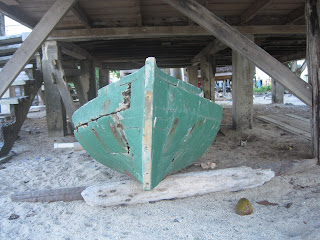Individual examples of even the simplest of types of watercraft can vary substantially from one another even when they are built within a limited geographic area for use in similar conditions. We discussed this recently in reference to coracles in the British Isles, and we found it to be equally true concerning dugout canoes in Belize. (See our previous post on our Belizean dugout "field work.")
Although many of Belizean dugouts we observed were in poor condition, they were all well designed and well crafted, revealing a sophisticated understanding of hull form and how it influences boat performance. Differences in hull form is the topic of this photo essay.
All the canoes below were photographed in the village of Hopkins, in the Stann Creek district, except one, which was found in Monkey River Town, in the Toledo district. The two are less than 40 miles apart as the crow flies.
First, we'll take a look at the forward sections.
Now we'll compare entries:
Sterns also exhibit a great range of shapes, with the presence of transom sterns and canoe sterns making the most significant difference.
In our next installment in this series on Belizean dugouts, we'll look at construction details.
Although many of Belizean dugouts we observed were in poor condition, they were all well designed and well crafted, revealing a sophisticated understanding of hull form and how it influences boat performance. Differences in hull form is the topic of this photo essay.
All the canoes below were photographed in the village of Hopkins, in the Stann Creek district, except one, which was found in Monkey River Town, in the Toledo district. The two are less than 40 miles apart as the crow flies.
First, we'll take a look at the forward sections.
 |
| Round-bottomed with fuller bilges. |
 |
| Much broader relative to depth, with a somewhat V'd bottom and slacker bilges. |
 |
| Very lengthy, very hollow entry waterlines, from the bottom all the way to the deck. |
 |
| Shorter entry and considerably less hollow: at the deck, the waterlines are nearly straight. |
 |
| Hollow entry from bottom to top, with very gentle waterlines and no appreciable shoulder. |
 |
| Much shorter entry: i.e., the bow here does not narrow down to a stem-like extension as in the previous canoe. This is the Monkey River canoe. |
 |
| Fairly straight waterlines near the top, angling back to shoulders set well back. Not very sleek, but there's a lot of buoyancy and carrying capacity in the bow. |
 |
| Now a look at different stem profiles. This one transitions from has a slightly sharp transition from the keep to the stem, which curves almost to vertical at the top. |
 |
| This transom stern, in contrast, are hollow. It's a rather tall but nicely shaped wineglass stern. |
 |
| In contrast to the dugout with the mounted outboard, this much shorter paddling dugout is much shapelier at the gunwale waterlines, being significantly convex nearly from stem to stern. |





0 Response to "Belizean Dugouts #2: Designs"
Post a Comment